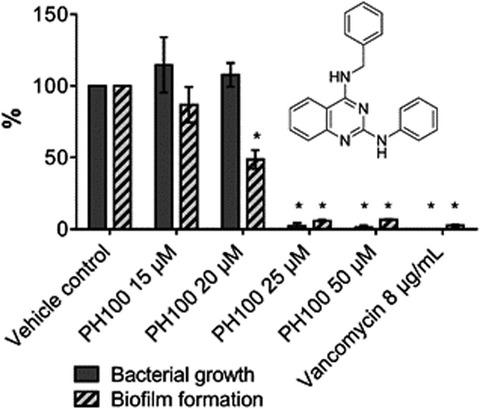当前位置:
X-MOL 学术
›
Chem. Bio. Drug Des.
›
论文详情
Our official English website, www.x-mol.net, welcomes your feedback! (Note: you will need to create a separate account there.)
N4 -benzyl-N2 -phenylquinazoline-2,4-diamine compound presents antibacterial and antibiofilm effect against Staphylococcus aureus and Staphylococcus epidermidis.
Chemical Biology & Drug Design ( IF 3 ) Pub Date : 2020-06-16 , DOI: 10.1111/cbdd.13745 Sharon Vieira Dos Reis 1 , Nicole Sartori Ribeiro 1 , Débora Assumpção Rocha 2 , Isadora Serraglio Fortes 2 , Danielle da Silva Trentin 3 , Saulo Fernandes de Andrade 2 , Alexandre José Macedo 1, 2
Chemical Biology & Drug Design ( IF 3 ) Pub Date : 2020-06-16 , DOI: 10.1111/cbdd.13745 Sharon Vieira Dos Reis 1 , Nicole Sartori Ribeiro 1 , Débora Assumpção Rocha 2 , Isadora Serraglio Fortes 2 , Danielle da Silva Trentin 3 , Saulo Fernandes de Andrade 2 , Alexandre José Macedo 1, 2
Affiliation

|
Staphylococcus aureus and Staphylococcus epidermidis are the main agents involved with implant‐related infections. Their ability to adhere to medical devices with subsequent biofilm formation is crucial to the development of these infections. Herein, we described the antibacterial and antibiofilm activities of a quinazoline‐based compound, N4‐benzyl‐N2‐phenylquinazoline‐2,4‐diamine, against both biofilm‐forming pathogens. The minimum inhibitory concentrations (MIC) were determined as 25 µM for S. aureus and 15 µM for S. epidermidis. At sub‐MIC concentrations (20 µM for S. aureus and 10 µM for S. epidermidis ), the compound was able to inhibit biofilm formation without interfere with bacterial growth, confirmed by scanning electron microscopy. Moreover, surfaces coated with the quinazoline‐based compound were able to prevent bacterial adherence. In addition, this compound presented no toxicity to human red blood cells at highest MIC 25 µM and in vivo toxicity assay using Galleria mellonella larvae resulted in 82% survival with a high dose of 500 mg/kg body weight. These features evidence quinazoline‐based compound as interesting entities to promising applications in biomedical fields, such as antimicrobial and in anti‐infective approaches.
中文翻译:

N4-苄基-N2-苯基喹唑啉-2,4-二胺化合物对金黄色葡萄球菌和表皮葡萄球菌具有抗菌和抗生物膜作用。
金黄色葡萄球菌和表皮葡萄球菌是种植体相关感染的主要病原体。它们粘附在医疗器械上并随后形成生物膜的能力对于这些感染的发展至关重要。在此,我们描述了基于喹唑啉的化合物 N 4-苄基-N 2-苯基喹唑啉-2,4-二胺对两种生物膜形成病原体的抗菌和抗生物膜活性。金黄色葡萄球菌的最低抑制浓度 (MIC) 为 25 µM,表皮葡萄球菌为 15 µM 。在亚 MIC 浓度下(金黄色葡萄球菌为 20 µM,表皮葡萄球菌为 10 µM),通过扫描电子显微镜证实,该化合物能够在不干扰细菌生长的情况下抑制生物膜形成。此外,涂有喹唑啉类化合物的表面能够防止细菌粘附。此外,该化合物在最高 MIC 25 µM 时对人类红细胞没有毒性,并且使用大蜡螟幼虫进行的体内毒性试验在 500 mg/kg 体重的高剂量下获得了 82% 的存活率。这些特征证明喹唑啉类化合物是生物医学领域(例如抗菌和抗感染方法)中具有前景应用的有趣实体。
更新日期:2020-08-04
中文翻译:

N4-苄基-N2-苯基喹唑啉-2,4-二胺化合物对金黄色葡萄球菌和表皮葡萄球菌具有抗菌和抗生物膜作用。
金黄色葡萄球菌和表皮葡萄球菌是种植体相关感染的主要病原体。它们粘附在医疗器械上并随后形成生物膜的能力对于这些感染的发展至关重要。在此,我们描述了基于喹唑啉的化合物 N 4-苄基-N 2-苯基喹唑啉-2,4-二胺对两种生物膜形成病原体的抗菌和抗生物膜活性。金黄色葡萄球菌的最低抑制浓度 (MIC) 为 25 µM,表皮葡萄球菌为 15 µM 。在亚 MIC 浓度下(金黄色葡萄球菌为 20 µM,表皮葡萄球菌为 10 µM),通过扫描电子显微镜证实,该化合物能够在不干扰细菌生长的情况下抑制生物膜形成。此外,涂有喹唑啉类化合物的表面能够防止细菌粘附。此外,该化合物在最高 MIC 25 µM 时对人类红细胞没有毒性,并且使用大蜡螟幼虫进行的体内毒性试验在 500 mg/kg 体重的高剂量下获得了 82% 的存活率。这些特征证明喹唑啉类化合物是生物医学领域(例如抗菌和抗感染方法)中具有前景应用的有趣实体。



























 京公网安备 11010802027423号
京公网安备 11010802027423号